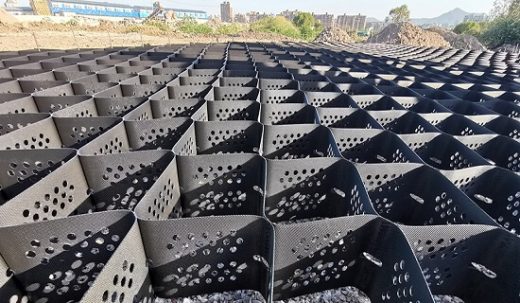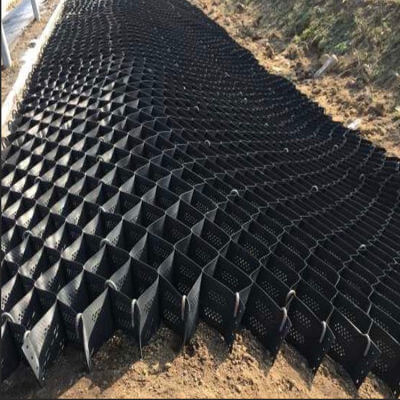Introduction:
Geocell is a cellular confinement system made from high-density polyethylene (HDPE) commonly used in road construction as a soil stabilization solution. Using geocell in road construction dates back to the 1970s when the U.S. Army Corps of Engineers developed the technology to stabilize the ground for military applications. The first documented use of geocell in road construction was in the late 1980s when the technology was used to stabilize the shoulders of an access road leading to a copper mine in Chile. This initial use was successful, and geocell began to gain popularity as a solution for soil stabilization in road construction projects worldwide.
Over the years, the technology has evolved, and the use of geocell has expanded to include applications in retaining walls, erosion control, and even green roofs. Today, geocell is a widely accepted and cost-effective solution for soil stabilization in road construction projects, particularly in areas with poor soil conditions or unstable terrain.
What is Geocell?
Geocell is a cellular confinement system used in civil engineering and construction projects to stabilize soil, prevent erosion, and reinforce soft ground. It consists of interconnected polyethylene strips, which are welded or woven together to form a three-dimensional honeycomb-like structure. The individual cells of the geocell are filled with compacted soil, gravel, or other materials, creating a stable platform for building roads, dams, retaining walls, and other structures. The interconnected cells help distribute the load more evenly, reducing stress on the soil and improving its load-bearing capacity.
Geocells are often used in applications such as slope stabilization, erosion control, and soil reinforcement in areas with poor soil conditions or soft ground. They are cost-effective, easy to install, and environmentally friendly, making them popular for many civil engineering and construction projects.
Types of Geocell:
1. Perforated Geocell:
Perforated Geocells are geosynthetic materials made of high-density polyethylene (HDPE) strips that are welded together to form a honeycomb-like structure. The cells are perforated, which means they have holes or slots that allow water to pass through the material. These geocells are commonly used in geotechnical engineering applications to stabilize soil, control erosion, and reinforce pavement structures. They are placed on the soil and filled with aggregate material such as gravel or crushed stone.

Fig1: Perforated Geocell
Courtesy: dezegabion.com
The perforations in the cells allow water to pass through, which reduces the buildup of hydrostatic pressure and helps to prevent water from accumulating in the soil. It can help prevent erosion and improve the stability of slopes. Perforated geocells are also used in pavement applications to improve the performance of roadways. The cells can be filled with aggregate material and then placed on top of a subgrade to create a stable base for the pavement. It helps to distribute the pavement load more evenly, reducing the risk of cracking and other types of damage. Perforated geocells are versatile and effective geosynthetic materials used in various applications to improve soil stability, prevent erosion, and reinforce pavement structures.
2. Non-Perforated Geocell:
A non-perforated geocell is a type of geosynthetic material made up of interconnected cells filled with soil, gravel, or other types of fill material. Unlike perforated geocells, which have small holes or perforations in the cell walls to allow for drainage, non-perforated geocells do not have any openings in the cell walls. Non-perforated geocells are typically used in applications where water drainage is not a concern, such as in the construction of dams, retaining walls, and other structures that require soil reinforcement. They are also commonly used for erosion control and soil stabilization.

Fig2: Non-Perforated Geocell
Courtesy: chinageomembrane.en.made-in-china.com
One of the advantages of non-perforated geocells is that they can be filled with a wide variety of materials, including locally available soil or construction waste, which can help reduce construction costs and environmental impact. Additionally, the interconnected cells of the geocell can help distribute loads more evenly, which can help improve the overall stability of the structure.
How Are Geocells Used in Road Construction?
Geocells are honeycomb-like structures made of high-density polyethylene (HDPE) that are commonly used in road construction to improve the stability and strength of subgrade soils. Here’s how geocells are used in road construction:
i) Soil Stabilization: Geocells are placed on the ground and filled with compacted soil. The cells create a confinement system that holds the soil in place, preventing lateral movement and increasing its shear strength. It stabilizes the subgrade and prevents it from settling or deforming under the weight of heavy traffic.
ii) Slope Erosion Control: Geocells are often used on slopes to prevent soil erosion. The cells can be filled with soil and vegetation, creating a vegetative cover that stabilizes the slope and preventing soil from washing away during heavy rains.
iii) Reinforced Earth: Geocells can be used as a reinforcing element in retaining walls and other earth structures. The cells are filled with soil, and the structure is built up layer by layer. It creates a stable, reinforced earth structure that can withstand heavy loads and lateral forces.
iv) Pavement Support: Geocells can be used to support pavement structures. The cells are placed on a prepared subgrade and filled with gravel or other aggregate materials. It creates a stable base that supports the weight of the pavement and distributes the load more evenly, reducing the risk of cracking and other pavement failures.
Advantages of Geocell:
i) Soil stabilization: Geocells help to stabilize soil and prevent erosion by confining the soil particles within the cells. It is particularly useful in slope stabilization, embankment construction, and soil reinforcement applications.
ii) Load distribution: Geocells distribute the load over a wider area, reducing the pressure on the underlying soil. It is ideal for load support applications such as road and railway construction.
iii) Environmental benefits: Geocells are made of 100% recycled HDPE, which makes them environmentally friendly. Additionally, they require fewer materials and resources to install, reducing their carbon footprint.
iv) Cost-effective: Geocells are cost-effective compared to traditional construction methods. They require less material and labor, reducing the overall project cost.
v) Easy installation: Geocells are easy to install and do not require specialized equipment. They can be installed quickly, saving time and labor costs.
vi) Versatility: Geocells can be used in various applications, including erosion control, soil stabilization, load support, and retaining wall construction.
Disadvantages of Geocell:
i) High cost: Geocells can be more expensive than traditional soil stabilization methods, such as concrete or asphalt. The cost of the geocell material and installation can add up quickly, especially for large-scale projects.
ii) Soil compaction: Geocells require heavy equipment to compact the soil during installation. This process can lead to soil compaction, which can reduce the permeability of the soil and affect its ability to absorb water.
iii) Limited applications: Geocells are unsuitable for all types of soil and terrain. They work best in flat or gently sloping areas and may not be appropriate for steep slopes or unstable soils.
iv) Maintenance: Geocells require regular maintenance to ensure their effectiveness. With proper maintenance, the cells can avoid becoming clogged with sediment, which can reduce their ability to control erosion and stabilize the soil.
v) Environmental concerns: Some geocell materials are made from plastics or other synthetic materials, which can raise environmental concerns, especially if they are not biodegradable or recyclable.
Conclusion:
Geocell technology has proven to be a reliable and cost-effective solution for various civil engineering and construction applications. Geocell is mostly used in construction to control and stop soil erosion, stabilize the soil, and strengthen the structure to hold loads. Geocell has been proven to be a strong, stable, and cost-effective way to build things. Geocell is usually used in a lot of projects that help the Earth. Its unique design and material properties have made it popular for engineers and contractors worldwide.
References:
1. Steffen, J. (2022, April 19). What is Geocell | Types of Geocell | Uses, Pros and Cons – ConstructUpdate.com. ConstructUpdate.com. https://www.constructupdate.com/what-is-geocell/
2. How Geocells Are Used in Road Construction. (n.d.). How Geocells Are Used in Road Construction. https://www.thomasnet.com/articles/plant-facility-equipment/geocells-in-road-construction/
3. Geocells in road construction: Its significance in civil construction. (2023, May 5). Singhal Industries – Manufacturer Exporter of Flexible Packaging Products. https://www.singhalglobal.com/blog/geocells-in-road-construction
4. The Benefits of Using Geocells. (n.d.). BlueStone Supply. https://bluestonesupply.com/pages/the-benefits-of-using-geocells
5. Geocell in Road Construction: Types, Application, Advantages & Disadvantages Of Geo Cell. (2022, November 28). Dream Civil?: Civil Engineering & Construction Informations. https://dreamcivil.com/geocell-in-road-construction/
5. What is Geocell Road | Use of Geocell in Road Construction. (n.d.). What Is Geocell Road | Use of Geocell in Road Construction. https://www.quantity-takeoff.com/geocell-in-road-construction.htm
If you have a query, you can ask a question here.


